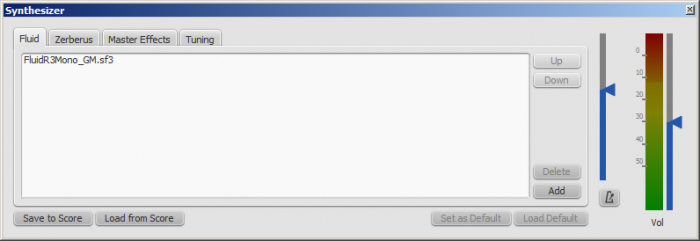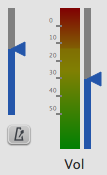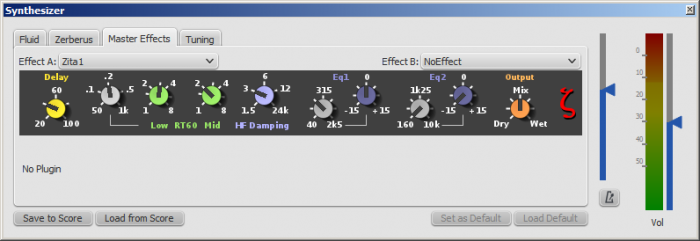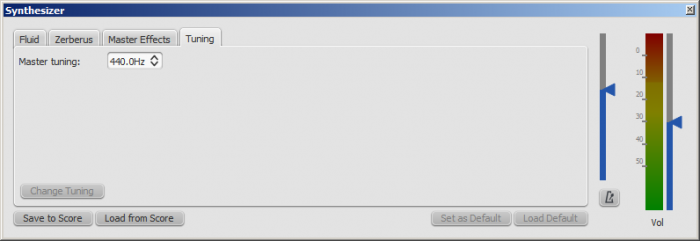Syntetisaattori
Overview
To display the Synthesizer: from the menu, select View→Synthesizer.
The Synthesizer controls MuseScore's sound output and allows you to:
- Load and organize different sound sample libraries to play back the music
- Apply effects such as reverb and compression
- Adjust overall tuning
- Alter the output volume of both music and the (optional) metronome.
The Synthesizer window is divided into four sections/tabs:
- Fluid: A software synthesizer that plays SF2/SF3 SoundFont sample libraries.
- Zerberus: A software synthesizer that plays SFZ format sample libraries.
- Master Effects: Used to apply multi-effects to the score.
- Tuning: Used to adjust overall playback tuning.
Synthesizer settings
Set as Default: When you open MuseScore, the Synthesizer always assumes the current default settings. If you want a new default to apply at the next session, change the settings as desired, then press the Set as Default button.
Save to Score / Load to Score: You can save a particular configuration of settings to an individual score by pressing the Save to Score button. When you next load the score, use the Load from Score button to transfer the stored settings to the Synthesizer.
Note: Only one set of Synthesizer settings can be in effect at a time—i.e. if multiple scores are open at once, it is not possible to make changes to the Synthesizer in one score and leave other scores' settings untouched.
Note: Changes made in the Synthesizer will not be heard in exported audio files unless the Synthesizer settings have been saved to the score with the Save to Score button. See also Tuning (below).
Fluid
Click on the Fluid tab to access the control panel for SF2/SF3 SoundFont sample libraries. By default, the SoundFont FluidR3Mono_GM.sf3 should already be loaded.

You can load, rearrange and delete soundfonts as required. Playback can be shared between any combination of different soundfonts (and/or SFZ files). The order of soundfonts in Fluid is reflected in the default order of instruments in the mixer.
To load a soundfont
- Click on the Add button
- Click on a soundfont in the list.
To be able to load the soundfont, it first needs to be installed in your Soundfonts folder. This will ensure that it appears in the list in step 2 (above).
To reorder the soundfonts
- Click on a soundfont
- Use the up/down arrows (on the right-hand side) to adjust the order.
- Repeat with other soundfonts in the list if required.
If you have not changed any sounds in the Mixer, then the SoundFont at the top of the list is the one that will be used for playback. However, if you are using the Mixer to play different instruments with sounds from different SoundFonts, playback will only work correctly if you have the same SoundFonts loaded in the same order in the Synthesizer. Therefore, if you are using multiple SoundFonts, it is advised to click the Save to Score button in the Synthesizer, so that the next time you open that score you can recall the list of SoundFonts loaded (and other Synthesizer settings) with the Load from Score button.
To remove a soundfont
- Click on the name of the soundfont
- Click on the Delete button.
This removes the soundfont from the synthesizer but does not uninstall it from the Soundfonts folder: it will still be available if you wish to reload it later.
Zerberus
Click on the Zerberus tab to access the control panel for SFZ sound sample libraries. You can add or delete files in a similar way to the Fluid tab. Note that, as with Fluid, the the SFZ files must first be installed in your soundfonts folder before they can be loaded into the synthesizer.
Volume
At the right in the Synthesizer are two sliders. One controls the playback volume, the other controls the volume of the optional built-in metronome. You can turn the metronome on or off by clicking the button underneath its volume slider. As with all the rest of the Synthesizer controls, any changes made here are temporary unless saved to the score or set as the new default.

Effects
The Master Effects tab of the Synthesizer houses the Zita 1 stereo reverb and, as of version 2.0.3, the SC4 stereo compressor modules. Two slots are provided, "Effect A" and "Effect B," both with a drop-down list of available effects – including the option to set one or both channels to "No Effect." The effects are applied in series: Effect A → Effect B.

To store an effects configuration as the default option for the synthesizer, click the Set as Default button. If you subsequently change the effects set-up, you can restore whatever settings you made the defaults by clicking the Load Default button.
You can store a particular effects configuration with a score by clicking on the Save to Score button, and later load those settings from the score by clicking on Load from Score.
Zita 1 reverb
The Zita 1 stereo reverb module allows you to simulate the ambience of anything from a small room to a large hall. The pre-delay, reverb time and tone of the reverb can be finely tuned using the controls provided:
- Delay: Set a pre-delay for the reverb from 20-100 ms.
- Low RT60 (Low frequency reverb time): Use the grey control to adjust the center frequency (50–1000 Hz) of the low frequency band which you want to affect: the green control adjusts the reverb time (1–8 secs) of this frequency band.
- Mid RT60 (Mid-range reverb time): Adjust the reverb time (1–8 secs) of the mid-range frequency band.
- HF Damping: Adjusts the high frequency component of the reverb. Increasing this value increases the frequency of the cut-off point and makes the reverb appear brighter and longer.
- EQ1: Allows you to cut or boost (-15 to +15) a frequency band (center = 40 Hz - 2 KHz) in the lower part of the spectrum.
- EQ2: Allows you to cut or boost (-15 to +15) a frequency band (center = 160 Hz - 10 KHz) in the higher part of the spectrum.
- Output: Controls the amount of effect applied. "Dry" is no effect. "Wet" indicates 100% reverb. "Mix" is a 50/50 balance of wet/dry signal.
Note: EQ1 and EQ2 affect the tone of the reverb only, not the dry (unprocessed) signal.
To quickly set up an effects patch, set "Output" to "Mix" and adjust the "Mid RT60" control to the desired reverb time. Then fine tune the effect as explained above.
SC4 compressor
The SC4 stereo compressor (available as of version 2.0.3) gives you fine control over the playback's dynamic range, reducing the volume variation between loud and soft sounds. It offers the following controls:
- RMS: Adjusts the balance between RMS (0) and Peak (1) compression. In the former, the compressor responds to averaged-out levels in the signal; in Peak mode, the compressor responds to peak levels.
- Attack: (1.5–400 ms) The length of time it takes for compression to engage fully after the signal exceeds the threshold level.
- Release: (2–800 ms) The time it takes for compression to return to zero after the signal falls below the threshold level.
- Threshold: (in dB) The signal level above which compression starts to take effect. Lowering the threshold increases the amount of signal that is compressed.
- Ratio: The amount of compression applied to the signal above the threshold. The higher the ratio, the greater the compression. Varies between 1:1 to 20:1.
- Knee: Allows you to select a range between "soft knee" and "hard knee". The softer the knee, the more gradual the transition between uncompressed and compressed signal.
- Gain: Compression tends to lower the volume, so use this control to boost the signal as required.
To quickly set-up, try setting RMS = 1, Threshold = -20 db, Ratio = 6. Increase Gain to restore the lost volume. Then fine-tune as explained above.
Tuning
For Concert Pitch instruments, MuseScore uses the A4 = 440 Hz pitch standard by default. To change it, simply enter a new value in the Tuning tab of the Synthesizer.

Like all other Synthesizer settings, the master tuning affects playback within MuseScore but does not affect exported audio files (WAV, OGG, MP3) unless the Save to Score option is selected.
Change master tuning
Notes: Applies to all scores. Current session only (tuning resets to default on MuseScore exit). Affects playback but doesn't affect exported audio files (WAV, OGG, MP3, and MIDI).
- View→Synthesizer.
- Click the Tuning tab.
- Enter a new Master Tuning value (Minimum value = 300 Hz; Maximum value = 600.0 Hz; Default 440 Hz).
- Click Change Tuning.
Set default tuning
Note: Applies to all scores. Current session and all subsequent sessions (until you change it again). Affects playback but doesn't affect exported audio files (WAV, OGG, MP3, and MIDI).
- Change the Master Tuning as shown above for the current session.
- Select Set as Default.
Change tuning for an individual score
Note: Applies to current score for current session, use the Save to Score button, and settings can be recovered in subsequent sessions with Load from Score. Affects playback and exported audio files (WAV, OGG, MP3).
- Change the Master Tuning as shown above for the current session.
- Click Save to Score.
- You will now get this new tuning in exported audio files of the current score, but other scores will export with the default tuning as expected. However, due to a limitation in MuseScore, you need to click Load from Score to get the correct tuning on playback.